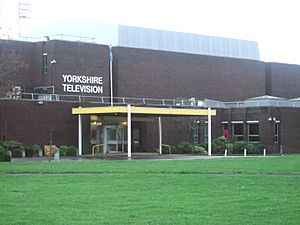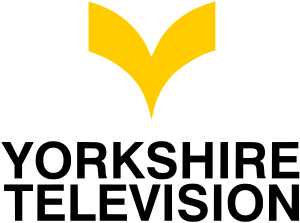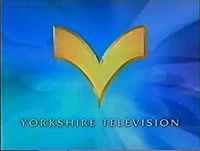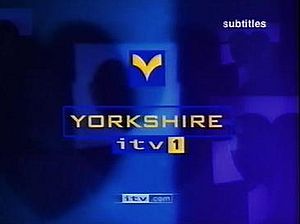ITV Yorkshire facts for kids

Logo used since 2013
|
|
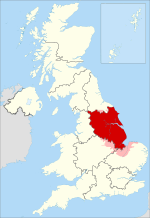 |
|
| Type | Region of television network |
|---|---|
| Branding | ITV1 |
| Country | United Kingdom |
| First air date | 29 July 1968 |
| Headquarters | Leeds, West Yorkshire |
| Broadcast area |
|
| Owner | ITV plc |
| Dissolved | lost on-air identity on 27 October 2002 (now known as ITV at all times) |
| Former names | Yorkshire Television |
| Picture format | 1080i HDTV, downscaled to 16:9 576i for SDTV |
| Affiliation | ITV |
| Language | English |
ITV Yorkshire is a British TV channel that broadcasts to the Yorkshire area. It was previously known as Yorkshire Television (or YTV). It's part of the bigger ITV network.
When it first started in 1968, it mainly covered the historic county of Yorkshire. Later, in 1974, its broadcast area grew to include parts of Lincolnshire, Norfolk, Derbyshire, and Nottinghamshire.
Two different groups wanted to run this TV channel. One group had a lot of money, and the other had better ideas for shows. They ended up joining forces to create Yorkshire Television.
Today, ITV Yorkshire is owned by ITV plc. The company that used to make the shows, Yorkshire Television Limited, stopped its main operations in 2007. However, the TV channel still exists and broadcasts under the ITV name.
Contents
History of ITV Yorkshire
ITV Yorkshire started in 1967. Back then, the ITV network decided to split up the big northern TV region. This meant a new TV channel was needed for Yorkshire.
Many groups applied for the new TV contract. The winning group was Telefusion Yorkshire Limited. They were chosen because they agreed to team up with another group called Yorkshire Independent Television. This second group had great ideas for TV shows but not much money. By joining together, they had both good ideas and enough funding.
The new TV station began broadcasting on 29 July 1968. It was based in brand-new studios in Leeds. These studios were specially built to make color TV shows. Even though they were ready for color, most shows were in black and white at first. Color TV officially started on 15 November 1969.
The first show on YTV was live coverage of a Test cricket match. Other early shows included their local news program, Calendar.
Early Challenges
In March 1969, the TV station faced a big problem. The main transmitter mast at Emley Moor collapsed because of heavy ice. This meant many people in the region couldn't watch Yorkshire Television. A temporary mast was quickly put up to get TV back on air.
By 1970, the company was doing well and making good profits. A new, stronger mast was built at Emley Moor in 1971. This brought full TV coverage back to the region.
In 1974, the broadcast area of YTV grew. The Belmont Transmitter, which used to serve another TV channel, was given to YTV. This helped YTV reach more towns like Hull and Lincoln.
Trident Television Era
In 1970, Yorkshire Television joined forces with its neighbor, Tyne Tees Television. They came under the control of a company called Trident Television. Even though they were linked, both stations still ran their own shows separately. They later split up again in 1981.
On 28 March 1977, Yorkshire Television tried something new. They launched Good Morning Calendar, which was one of the UK's first ever breakfast television shows. It ran for nine weeks.
Worker Challenges
From the start, Yorkshire Television had some challenges with its workers' unions. In 1971, technicians went on strike over pay. This caused a show to go off air early.
In 1978, another strike meant YTV was off the air during Christmas. For two days, people in the region had no TV at all! Many Christmas shows were shown later in 1979.
In 1979, a big ITV strike happened across the whole country. Yorkshire Television was off air for over two months. The company's leaders were very firm during this time.
Later Years and Changes
On 9 August 1986, Yorkshire Television became the first British TV station to broadcast 24 hours a day. They did this by showing a satellite music channel called Music Box overnight. This trial lasted for three months. 24-hour broadcasting officially returned in May 1988.
In 1992, Yorkshire Television and Tyne Tees Television joined forces again. They became Yorkshire-Tyne Tees Television plc. This led to some job cuts as the companies combined their operations.
In 1997, a big company called Granada Group bought Yorkshire-Tyne Tees Television. Granada changed the branding and moved some TV operations to Leeds. In 2002, Yorkshire Television was officially rebranded as ITV1 Yorkshire. The famous chevron logo stopped appearing after shows in 2004. Today, shows made at the Leeds studios are credited to ITV Studios.
Studios
The main studios for Yorkshire Television are located on Kirkstall Road in Leeds. They were built on land that used to be a slum.
Construction started in 1967. The studios were officially opened by The Duchess of Kent on 29 July 1968. They were the first studios in Europe built specifically for making color television shows! They cost over £4 million to build and equip.
The regional news show Calendar was made here for many years. In 1989, it moved to a special newsroom next to the main studios.
Many popular shows have been filmed at these studios, including Countdown (which later moved), Mastermind, and children's shows like My Parents Are Aliens. The studios are now known as The Leeds Studios.
In 2009, ITV plc planned to close many parts of the Leeds Studios. However, they changed their minds. Instead, they decided to move the production of the popular soap opera Emmerdale to Kirkstall Road and upgrade the studios for HDTV (high-definition TV).
Identity
For nearly 35 years, Yorkshire Television's on-screen look always featured its special logo: the chevron. This yellow symbol was seen on almost all of YTV's idents (short clips shown between programs).
The very first logo was black and white. It was shown with an orchestral version of "On Ilkla Moor Baht 'at", a famous Yorkshire folk song. This song later became the station's jingle.
When color broadcasts started in 1969, the logo became a yellow chevron on a black background. The jingle was also simplified. Over the years, the logo and jingle changed slightly. Sometimes, the idents would show the chevron with slogans like "Serving Six Million Viewers".
In 1987, a new ident called "Liquid Gold" was introduced. It showed a pool of gold with the chevron rising from it. This ident had a full orchestral version of the theme tune and cost a lot of money to make!
1990s Changes
In 1989, Yorkshire Television adopted a new look shared by many ITV channels. This featured a large ITV logo.
In 1994, YTV introduced a new ident with a textured background. It showed images of the Yorkshire region with the chevron in the middle. This version used a smooth orchestral jingle instead of the folk song.
In 1996, Yorkshire-Tyne Tees Television tried a new brand called "Channel 3". In Yorkshire, the chevron logo still appeared, but it was often shown with the number '3'. The "On Ilkla Moor Baht 'at" tune also returned, but at a higher pitch.
This "Channel 3" look was dropped in 1998. The logo went back to a spinning chevron on a misty blue background.
In 1999, Yorkshire Television adopted another shared ITV look, this time based on hearts. For local shows, Yorkshire still used its own ident with spinning chevrons and pictures of the region.
2000s and Today
On 28 October 2002, Yorkshire Television became ITV1 Yorkshire. The local identity was mostly dropped, except for local programs. By 2006, these regional idents were removed completely. Today, shows made in Leeds are simply credited to ITV Studios.
Continuity Announcers
- Redvers Kyle (1968–1993)
- Bob Preedy (late 1980s – 2002)
- John Crosse (early 1970s – 1998)
- Graham Roberts (c. 1970s – 1993)
- Kerrie Gosney (2000–2002)
- Earl Richmond (1968 – c.1970s)
- Neil Didsbury (2001–2002)
- Pete Haslam (1999 – c.2007)
- Peter Lewis (late 1960s)
- Keith Martin
- Maggie Mash (1988–2002)
- Nick Oliver
- Karen Petch (deceased)
- Paul Lally (c.1968 – 1990s)
- Ian de Stains (1968–1970)
- Paul Kaye (c.1970s – 1980)
- Helen Aitken (1995–2002)
- Roger Tilling (1998–2002)
- Colin Weston (freelancer)
- Stephen Whitlock (1992–2004)
Programming

Yorkshire Television made many different kinds of shows for the ITV network. The famous presenter Alan Whicker even owned shares in the company and made many programs for them.
Drama and Serials
Yorkshire Television had many successful drama shows, including:
- A Touch of Frost
- At Home with the Braithwaites
- The Beiderbecke Trilogy
- The Darling Buds of May
- Emmerdale
- Fat Friends
- Heartbeat
- The Royal
- Trial & Retribution
In 1972, YTV launched a daytime drama called Emmerdale Farm. This show is still on TV today and is now simply called Emmerdale.
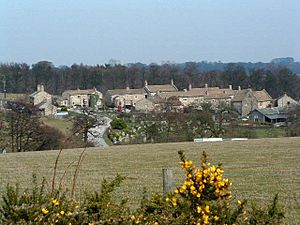
Comedy and Sitcoms
Yorkshire TV also produced many popular comedy shows and sitcoms, such as:
- Duty Free
- Hallelujah!
- Home to Roost
- In Loving Memory
- The New Statesman
- Oh No It's Selwyn Froggitt
- Only When I Laugh
- Queenie's Castle
- Rising Damp
- That's My Boy
- You're Only Young Twice
These shows helped make many British comedians and actors famous.
Children's Shows
YTV made many shows for children that were shown across the network, including:
- Animal Kwackers
- Bad Influence!
- Follyfoot
- My Parents Are Aliens
- Puddle Lane
- The Book Tower
- The Flaxton Boys
- The Raggy Dolls
- The Riddlers
They also made How We Used To Live for schools and colleges.
Entertainment and Game Shows
Yorkshire TV produced many popular quiz and game shows, such as:
- 3-2-1
- Bruce's Price is Right
- Countdown (for Channel 4)
- Winner Takes All
They also made religious shows like Stars on Sunday.
Special Broadcasts
The company was very good at covering live events. They often broadcast horse racing and other sports events from the north of England.
YTV also became known for its award-winning documentaries. In 1979, their documentary Rampton: The Secret Hospital showed how patients were treated at a mental hospital. This led to a government investigation and won an international award.
Yorkshire Television was often a leader in British commercial TV. They built the first color TV studios in Europe. They were also the first to try breakfast television in 1977.
In 1986, YTV became the first regular TV station in Britain to broadcast 24 hours a day. They did this by showing a music channel overnight.
See also
 In Spanish: ITV Yorkshire para niños
In Spanish: ITV Yorkshire para niños


